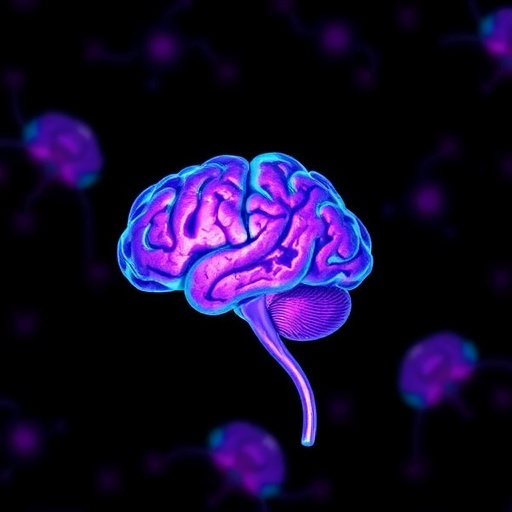A recent study conducted by a dedicated team at the Texas Tech University Health Sciences Center (TTUHSC) brings forth groundbreaking evidence regarding the blood-brain barrier (BBB) in a widely utilized mouse model of Alzheimer’s disease. This pivotal research suggests that the BBB remains primarily intact, challenging long-established beliefs that the condition leads to significant leakage in this protective shield. Alzheimer’s disease, characterized by debilitating memory loss and cognitive decline, often prompts discussions about its impact on the BBB, which is a complex structure that restricts harmful substances while allowing necessary nutrients to enter the brain.
The team’s findings were published on July 23 in the prestigious journal Fluids and Barriers of the CNS. This collaborative effort involved researchers from TTUHSC’s Jerry H. Hodge School of Pharmacy in Amarillo, and the Graduate School of Biomedical Sciences. Helmed by principal investigator and senior author, Dr. Ulrich Bickel, with lead author Ehsan Nozohouri — a TTUHSC graduate research assistant — the study also included contributions from other graduate researchers within the institution. Their combined expertise and innovative methodologies culminated in a transformative understanding of the BBB in the context of Alzheimer’s pathology.
Historically, scholars have debated whether Alzheimer’s disease results in the impairment of the BBB. Traditionally perceived as a protective barrier, the BBB is made up of tightly connected endothelial cells that serve as a gate, determining what enters the brain from the bloodstream. The prevailing theory suggested that the onset of Alzheimer’s could compromise the integrity of this barrier, leading to a situation where harmful compounds could enter the brain and exacerbate the disease.
The implications of this study are profound for the field of Alzheimer’s research. Ehsan Nozohouri elucidated that understanding the integrity of the BBB becomes critical, particularly for drug delivery systems intended to treat Alzheimer’s disease. Since the BBB effectively blocks the majority of medications, revealing its actual condition in Alzheimer’s provides essential insights for future therapeutic strategies.
In their investigation, Nozohouri and his colleagues employed the Tg2576 mouse model, which is well-documented for its propensity to develop amyloid beta plaques synonymous with Alzheimer’s pathology. To probe the integrity of the BBB, the research team injected a harmless test molecule, [¹³C₁₂]sucrose, a compound known for its poor ability to cross the BBB. By utilizing advanced analytical techniques, including liquid chromatography coupled with tandem mass spectrometry (LC-MS/MS) and laser microdissection for precise tissue sampling, they meticulously monitored the presence of sucrose in various brain regions.
The results were striking. The examination revealed no significant leakage of sucrose into the brain of either the Alzheimer’s-afflicted Tg2576 mice or their healthy counterparts, at varying ages. This indicates that the BBB is not compromised on a broad scale in this model, and highlights the need for re-evaluation of the theories surrounding BBB permeability in Alzheimer’s disease.
Furthermore, the study suggested that within critical regions of the brain associated with memory and cognitive function, there were no significant differences present between the Alzheimer’s models and healthy mice. This included the examination of tight junction proteins, which function as the “mortar” that holds BBB cells together, again showing largely preserved structures even in proximity to amyloid plaques.
As the scientists contemplate these results, they emphasize that their findings challenge the widespread assumption of extensive BBB leakiness in Alzheimer’s disease. Such revelations could catalyze a paradigm shift in how drugs are designed for effective treatment, as the understanding needs to pivot towards recognizing that the BBB may not universally be compromised in the disease.
Despite the promising nature of the findings from the Tg2576 model, Nozohouri cautioned against a sweeping application of these conclusions to human physiology. The researchers stressed the necessity for additional models that may more accurately reflect human brain responses and the intricacies of Alzheimer’s disease. As the field looks forward, there exist FDA-approved monoclonal antibody treatments showing potential in slowing cognitive decline. Further examination of these therapeutics in relevant models could illuminate pathways whereby localized changes affect drug effectiveness, especially concerning concerns of micromorphological alterations like microhemorrhages.
The team at TTUHSC envisions this research as a starting point for expanded inquiries into the dynamics of Alzheimer’s disease and the BBB. They are committed to further studying how Alzheimer’s may impact the brain’s protective mechanisms and ultimately aspire to hone drug development strategies that can effectively navigate the complexities of the BBB and deliver meaningful therapeutic ramifications to patients suffering from this debilitating condition.
This investigation underscores an urgent need for more refined understanding and innovative strategies in combating Alzheimer’s disease. With the stakes high, researchers are poised to explore the intersections of neuroscience, pharmacology, and therapeutic innovation, all with the overarching goal of improving the lives of those impacted by this formidable disease.
The work done by this team moves us a step closer to unraveling the complexities of Alzheimer’s disease and the mechanisms underpinning its effects on the brain. By shedding light on the actual state of the BBB, they pave the way for future advancements in treatment strategies and foster hope for more effective interventions in the ever-challenging landscape of Alzheimer’s research.
Subject of Research: Animals
Article Title: Assessing blood-brain barrier (BBB) integrity in an Alzheimer’s disease mouse model: is the BBB globally or locally disrupted?
News Publication Date: 23-Jul-2025
Web References: DOI
References: None available
Image Credits: Credit: TTUHSC
Keywords
Biomedical engineering, Clinical medicine, Diseases and disorders, Epidemiology, Health care, Human health, Medical specialties, Pharmaceuticals, Pharmacology.





